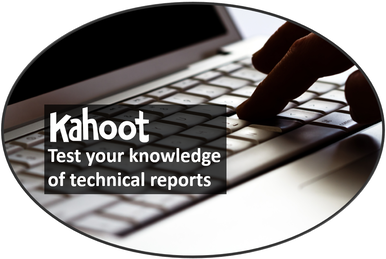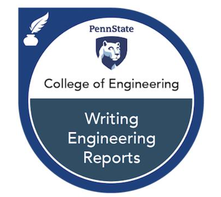Tutorial: 15 minutes
Writing Reports in Engineering and Science
|
Summary for Tutorial. Instructors: You are more than welcome to assign this tutorial to your students. Also, if you would like a Canvas quiz of the Kahoot to verify that your students have done the tutorial, please visit the Canvas quiz page.
|
1. Watch Films
|
Film 1. Organizing Reports. |
Film 2. Writing Precise and Clear Sentences for Reports. |
|
Film 3. Incorporating Illustrations and Equations into Reports. |
2. Play Kahoot
|
Appendix A: Additional Resources on Writing Reports
The following resources discuss additional perspectives on writing reports in engineering and science. Film A-1, for instance, presents a process that professional teams use to produce effective reports. In addition, Film A-2 discusses how having different audiences affects the way that you write reports. Discussed in Film A-3 are guidelines for writing in sections, and Film A-4 discusses best writing practices to avoid ambiguities in scientific writing. Presented in Film A-5 and its accompanying handout is an effective strategy to connect sentences in the paragraphs of reports. Still more films can be found in the 1-hour Tutorial on Writing Reports in Engineering and Science. Working through that tutorial allows Penn State students to earn a credentialing badge.
The following resources discuss additional perspectives on writing reports in engineering and science. Film A-1, for instance, presents a process that professional teams use to produce effective reports. In addition, Film A-2 discusses how having different audiences affects the way that you write reports. Discussed in Film A-3 are guidelines for writing in sections, and Film A-4 discusses best writing practices to avoid ambiguities in scientific writing. Presented in Film A-5 and its accompanying handout is an effective strategy to connect sentences in the paragraphs of reports. Still more films can be found in the 1-hour Tutorial on Writing Reports in Engineering and Science. Working through that tutorial allows Penn State students to earn a credentialing badge.
|
Film A-1. Process of Writing Reports as a Team Film A-3. Writing in Sections. Film A-5. Connecting Ideas in the Paragraphs of Reports. |
Film A-2.Analyzing Audience of Reports. Film A-4. Avoiding Ambiguities in Scientific Writing. |
|
Acknowledgments
This tutorial, which was created in the College of Engineering at Penn State, is made possible by funding from the College's Leonhard Center for Engineering Education. Providing technical assistance on the films has been the Office of Digital Learning, which is also in the College. |
|
Faculty and Staff Editors
Michael Alley, Content Editor, Teaching Professor Casey Fenton, Film Editor, Office of Digital Learning Richelle Weiger, Film Editor, Office of Digital Learning Elaine Whitmer, Film Editor, Office of Digital Learning |
Former Student Editors
Morgan Aloi, ME, 2022 Olivia Brencovich, ME, 2022 Justin Bardy, ME, 2021 Alexus Eicher, Comp Sci., 2021 Dean Ellis, Aerospace Engr., 2021 Jake Grant, ME, 2022 Alexander How, ME, 2021 Belinda Mativenga, ChE, 2022 Kaitlyn Pigeon, IE, 2021 Alison Wanamaker, IE 2021 Mia Wanyo, ME, 2022 |
References
- Michael Alley, The Craft of Scientific Writing, 4th ed. (New York: Springer, 2018).
- "Report Templates," Writing as an Engineer or Scientist, ed. by Michael Alley (University Park, PA: College of Engineering, 1996).
- "Sample Report Format," Writing as an Engineer or Scientist, ed. by Michael Alley (University Park, PA: College of Engineering, 1996).


